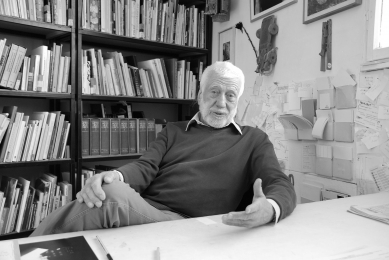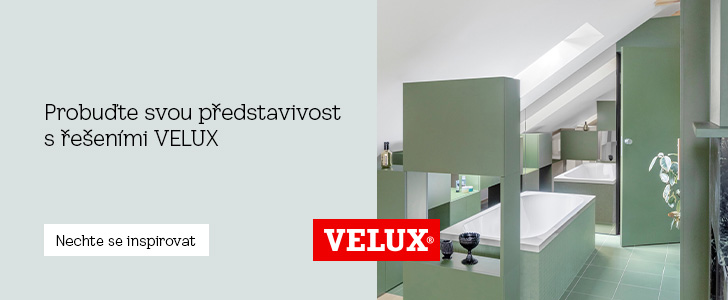
To the death of Günther Feuerstein
At the beginning of December, the Austrian architectural scene lost one of its greatest visionaries and a key figure who was behind avant-garde associations such as Coop Himmelb(l)au, Haus-Rucker-Co, and Zünd-up.
Günther Feuerstein was a Viennese patriot. He was born here, studied, worked, lived, and on Saturday, December 4, 2021, he also passed away at the admirable age of 96. He studied architecture at the Vienna University of Technology in the early 1950s. At the turn of the 50s and 60s, he worked in the studio of modernist architect Karl Schwanzer, where he contributed to the iconic project of the Austrian pavilion for the 1958 World Expo in Brussels. In the 1960s, he was Schwanzer's assistant at the Institute of Theory and Design of Buildings at the Technical University of Vienna. He organized Architecture Students' Club Seminars and was in charge of summer workshops for designing experimental buildings. His lectures acted as a catalyst for the development of Viennese architecture in the 1960s. As part of his lecture series, he invited controversial guests, which eventually led to his dismissal from the university (the lecture hall 14a now bears his name). Subsequently, between 1970 and 1972, he organized extra-university discussion forums in his private studio that transcended the field of architecture. From 1973 to 1996, he served as a professor of spatial design at the University of Linz. In 2008, he moved to the Institute of Experimental Architecture at the University of Innsbruck, which awarded him an honorary doctorate last year.
In addition to his educational activities, he was also active in the media scene. In the mid-1960s, he was part of the editorial team of the magazine BAU, along with Gustav Peichl and Hans Hollein. During the 1970s and 1980s, he edited the magazine Transparent and contributed to several newspapers.
Wolf D. Prix also dedicated a remembrance to Günther Feuerstein on the homepage of his studio with the following message: “Günther was the best teacher – not just for my generation. Back then, as Schwanzer's assistant (always in a white coat), it was he who, in a nearly American style, gathered what he deemed the most talented students at the so-called ‘Club Seminar’. And in discussions that greatly exceeded the technical lectures of the time, he explained that architecture is more than a 7.50m modular grid. I will never forget the personal conversations – then still called corrections – in his assistant's office. His comments on our projects were always kind. He could sometimes be very cheeky as well, but his remark 'no models, no conversation' resonates in my teaching style and my work on projects to this day.”
Günther Feuerstein was introduced to the Czech audience through the exhibition Changing the World about Austrian visionary architecture of the 60s and 70s, which he prepared in 1999 for the Jaroslav Fragner Gallery in Prague.
More information >
Günther Feuerstein was a Viennese patriot. He was born here, studied, worked, lived, and on Saturday, December 4, 2021, he also passed away at the admirable age of 96. He studied architecture at the Vienna University of Technology in the early 1950s. At the turn of the 50s and 60s, he worked in the studio of modernist architect Karl Schwanzer, where he contributed to the iconic project of the Austrian pavilion for the 1958 World Expo in Brussels. In the 1960s, he was Schwanzer's assistant at the Institute of Theory and Design of Buildings at the Technical University of Vienna. He organized Architecture Students' Club Seminars and was in charge of summer workshops for designing experimental buildings. His lectures acted as a catalyst for the development of Viennese architecture in the 1960s. As part of his lecture series, he invited controversial guests, which eventually led to his dismissal from the university (the lecture hall 14a now bears his name). Subsequently, between 1970 and 1972, he organized extra-university discussion forums in his private studio that transcended the field of architecture. From 1973 to 1996, he served as a professor of spatial design at the University of Linz. In 2008, he moved to the Institute of Experimental Architecture at the University of Innsbruck, which awarded him an honorary doctorate last year.
In addition to his educational activities, he was also active in the media scene. In the mid-1960s, he was part of the editorial team of the magazine BAU, along with Gustav Peichl and Hans Hollein. During the 1970s and 1980s, he edited the magazine Transparent and contributed to several newspapers.
Wolf D. Prix also dedicated a remembrance to Günther Feuerstein on the homepage of his studio with the following message: “Günther was the best teacher – not just for my generation. Back then, as Schwanzer's assistant (always in a white coat), it was he who, in a nearly American style, gathered what he deemed the most talented students at the so-called ‘Club Seminar’. And in discussions that greatly exceeded the technical lectures of the time, he explained that architecture is more than a 7.50m modular grid. I will never forget the personal conversations – then still called corrections – in his assistant's office. His comments on our projects were always kind. He could sometimes be very cheeky as well, but his remark 'no models, no conversation' resonates in my teaching style and my work on projects to this day.”
Günther Feuerstein was introduced to the Czech audience through the exhibition Changing the World about Austrian visionary architecture of the 60s and 70s, which he prepared in 1999 for the Jaroslav Fragner Gallery in Prague.
More information >
The English translation is powered by AI tool. Switch to Czech to view the original text source.












